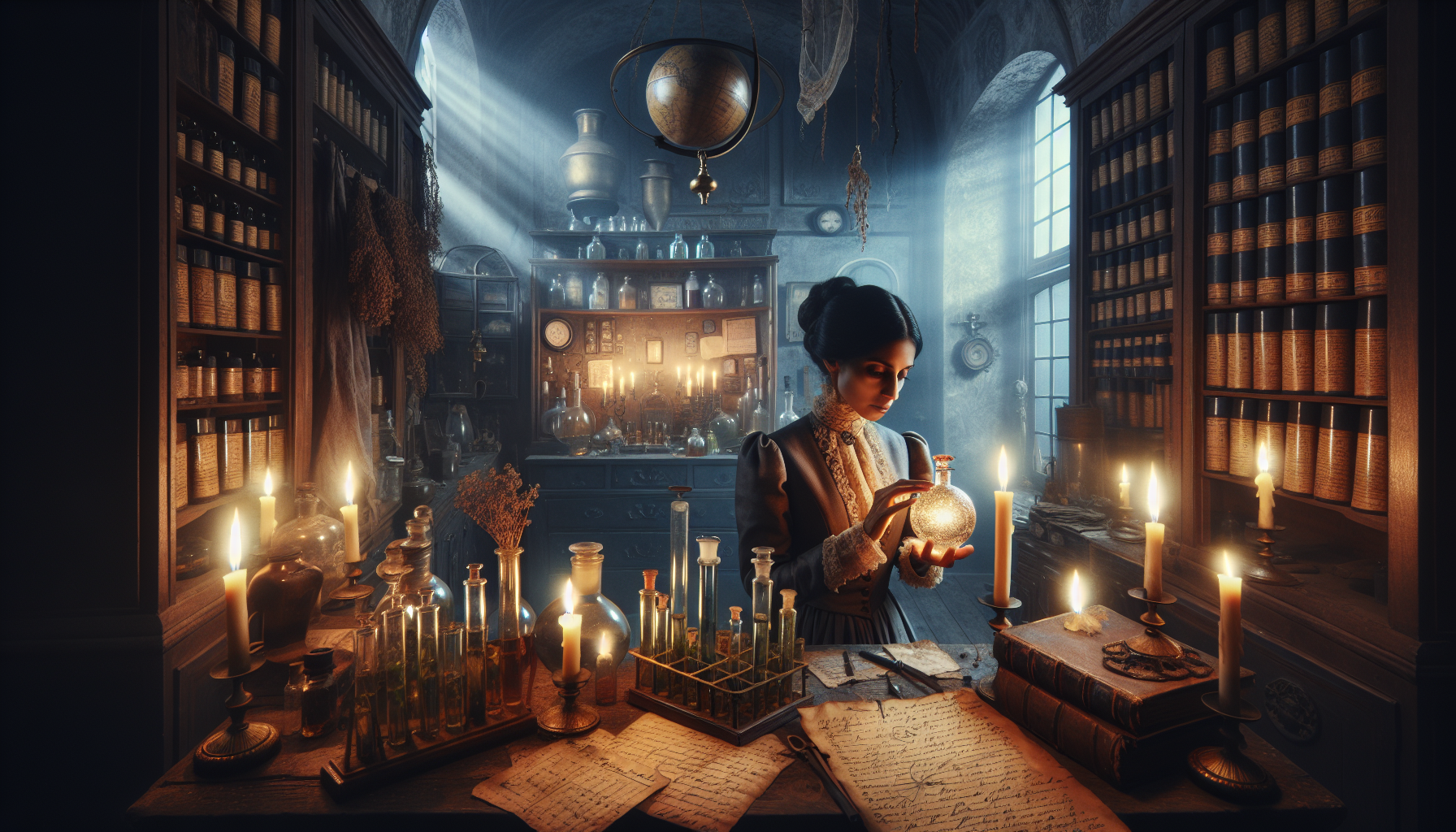In the dim glow of candlelit parlors and amidst the flicker of gas lamps, a tantalizing obsession swept across the 19th century: the quest for immortality. While the world was undergoing profound changes with the Industrial Revolution, a parallel narrative unfolded in the hushed corridors of alchemists’ laboratories and the grand halls of scientific societies. It was a time when the boundaries between science and mysticism blurred, giving rise to an era filled with wonder, curiosity, and the relentless pursuit of life everlasting. In this article, we embark on a fascinating journey through history to uncover the elusive elixirs that promised immortality and delve into the minds of those who dared to chase the impossible dream of eternal life.
The 19th century, a period marked by rapid advancements and discoveries, was fertile ground for the emergence of immortality elixirs. Scientists and charlatans alike claimed to have unlocked the secrets of perpetual youth, offering potions and concoctions that promised to halt time and defy death. These elixirs were more than mere medicinal brews; they were symbols of hope and the ultimate testament to human ingenuity and ambition. From the bustling streets of Paris to the quiet countryside of England, stories of miraculous cures and mysterious brews captivated the imagination of the masses. But what ingredients did these potions contain? Were they merely products of pseudoscience, or did they hold kernels of truth that science would later unravel? 🧪
Throughout this exploration, we will delve into the lives of the intriguing figures who became synonymous with this quest—visionary scientists, eccentric inventors, and daring adventurers. We will examine the cultural and scientific landscape that made the 19th century a hotbed for such endeavors and unravel the myths from the realities. Along the way, we’ll uncover how these historical pursuits echo in today’s scientific community, as modern researchers continue to chase the dream of extended longevity. Join us as we venture into the past, revealing the secrets and stories of the immortality elixirs of the 19th century—a saga of ambition, innovation, and the timeless human desire to transcend the confines of mortality. 🌟
The Quest for Immortality: A 19th Century Obsession
The 19th century was a period characterized by significant scientific breakthroughs, societal changes, and the relentless pursuit of knowledge. Among the various quests of this era, the search for immortality stood out as both a scientific endeavor and a philosophical pursuit. The fascination with extending human life and possibly achieving eternal youth captivated the minds of many, leading to the creation and popularization of various “immortality elixirs.” This was a time when alchemy and emerging chemistry intersected, creating a fertile ground for experimentation and innovation.
During this century, the line between science and pseudoscience was often blurred. The quest for the elixir of life was no exception. Prominent figures, from scientists to charlatans, claimed to have discovered secret formulas that promised prolonged life or even immortality. These concoctions often contained exotic ingredients, ranging from herbal mixtures to more mysterious and esoteric components. The allure of eternal youth was so potent that it transcended class and geographical boundaries, with both the wealthy and the common seeking the promise of a longer, healthier life.
Elixirs and Their Ingredients: A Glimpse into the Past
In the 19th century, numerous elixirs purported to offer the key to immortality. These potions were often a blend of both scientific knowledge and mystical beliefs, reflecting the transitional period between traditional alchemy and modern chemistry. Common ingredients included botanical extracts, minerals, and, occasionally, more unconventional substances. Let’s explore some of these fascinating concoctions and their components.
One popular ingredient in these elixirs was ginseng, a plant known for its supposed rejuvenating properties. Ginseng was believed to enhance vitality and energy, making it a common component in tonics aimed at extending life. Similarly, gold, a symbol of immortality and incorruptibility, was used in various forms. Gold-based elixirs were thought to purify the body and spirit, aligning with the alchemical belief in the metal’s life-giving properties.
Other ingredients included mercury, which was considered a mystical substance capable of transforming base metals into gold and providing eternal life. However, the toxic nature of mercury made these elixirs dangerous, often leading to more harm than benefit. Despite the risks, the promise of immortality overshadowed concerns, showcasing the powerful allure these potions held over those who sought them.
Comparative Analysis of Notable Elixirs
| Elixir Name | Key Ingredients | Claimed Benefits |
|---|---|---|
| Elixir of Life | Ginseng, Gold, Mercury | Longevity, Vitality, Eternal Youth |
| Fountain of Youth Tonic | Herbal Extracts, Alcohol, Honey | Rejuvenation, Increased Energy |
| Alchemist’s Potion | Lead, Sulfur, Mercury | Transformation, Spiritual Enlightenment |
As illustrated in the table above, these elixirs often combined both natural and mystical elements. While some were based on botanical knowledge, others relied heavily on alchemical practices and ancient beliefs. The combination of such diverse ingredients highlights the experimental nature of the era and the lengths to which individuals would go in their quest for immortality.
The Influence of Alchemy and Emerging Sciences
Alchemy played a pivotal role in the development of immortality elixirs. The alchemists of the 19th century were seen as both magicians and proto-scientists, straddling the line between mystical traditions and emerging scientific methods. Their work laid the groundwork for many of the chemical advancements that would follow, and their quest for the Philosopher’s Stone—a substance said to grant eternal life and turn base metals into gold—echoed in the immortality elixirs of the time.
The transition from alchemy to chemistry brought about a more systematic approach to understanding the natural world. This shift influenced the formulation of elixirs, as practitioners began to apply scientific principles to their creations. The isolation of elements, study of reactions, and identification of chemical compounds contributed to more refined and sophisticated concoctions. However, the allure of mystical properties remained, reflecting the persistent influence of alchemical thought.
The 19th century was also a period of burgeoning medical knowledge. Discoveries in anatomy, physiology, and disease prevention gradually shifted the focus from mystical remedies to scientifically backed treatments. Nevertheless, the idea of an immortality elixir persisted, as the concept was deeply ingrained in human culture and imagination. The merging of alchemical beliefs with emerging scientific practices resulted in a fascinating blend of knowledge that characterized the era’s approach to immortality.
Alchemy’s Enduring Legacy in Modern Times
While alchemy as a formal practice declined with the rise of modern science, its influence can still be seen today. The symbolic language of alchemy, with its emphasis on transformation and purification, resonates in various fields, from psychology to spirituality. The search for immortality, though more grounded in scientific research now, still echoes the age-old alchemical quest for transcendence and eternal life.
Modern scientists continue to explore the possibilities of extending human lifespan through genetics, biotechnology, and medicine. However, the dream of immortality remains elusive. The 19th-century elixirs, with their blend of mysticism and emerging science, serve as a reminder of humanity’s enduring desire to conquer mortality. In a world where technological advancements are rapidly changing our understanding of life, the quest for immortality remains a testament to human curiosity and ambition.
For those interested in a deeper dive into the fascinating world of alchemy and its quest for immortality, we recommend watching the following video on YouTube: “Alchemy: The Science of Magic” – The History Channel. This video provides an insightful look at the history of alchemy and its lasting impact on science and culture.
- Explore the historical context of 19th-century immortality elixirs.
- Understand the influence of alchemy and its transition to chemistry.
- Discover the ingredients and claims of various elixirs from the era.
- Learn about the enduring legacy of alchemical thought in modern science.

Conclusion
**Conclusion: Unlocking the Mysteries of Immortality Elixirs of the 19th Century**
In the tapestry of human history, the quest for immortality has been a vibrant thread woven through time, emblematic of our enduring desire to transcend the limits of life. As we navigated the fascinating exploration of 19th-century immortality elixirs, several key points emerged, shedding light on both the scientific endeavors and the cultural perceptions of the era.
Firstly, the 19th century was a period of tremendous curiosity and experimentation. Scientists and alchemists alike were captivated by the possibility of extending human life, leading to numerous concoctions and potions that promised vitality and longevity. These elixirs, often shrouded in mystery and skepticism, represented the intersection of emerging scientific knowledge and ancient alchemical traditions. The period saw figures like Thomas Edison and Marie Curie experimenting with new technologies and elements, with some ventures bordering on the mystical [1].
Secondly, the cultural and philosophical context of the 19th century played a significant role in shaping the pursuit of immortality. The era was marked by a burgeoning interest in spiritualism and the occult, providing fertile ground for the proliferation of elixirs that claimed to unlock the secrets of eternal life. This intersection of science and mysticism reflected a society grappling with rapid changes and uncertainties, seeking solace in the possibility of immortality [2].
Moreover, the 19th-century fascination with immortality elixirs was not merely a scientific pursuit but also a reflection of broader societal aspirations and anxieties. As industrialization accelerated, transforming the social fabric and introducing unprecedented levels of change, the desire to control life and death became more pronounced. Elixirs promised a semblance of control over one’s destiny, a powerful allure in an age of uncertainty [3].
The exploration of these themes highlights the enduring human quest for immortality, a pursuit that transcends time and culture. While the 19th-century elixirs often failed to deliver on their promises, they paved the way for future scientific inquiry into the nature of life and aging. Today, modern science continues to explore the possibilities of extending human life, drawing inspiration and caution from the lessons of the past [4].
In reflecting on the topic of 19th-century immortality elixirs, we are reminded of the importance of balancing curiosity with skepticism. The era serves as a testament to human ingenuity and the unyielding spirit of discovery. It also underscores the necessity of ethical considerations in scientific exploration, a lesson that remains as relevant today as it was over a century ago.
As we conclude this exploration, I encourage you, the reader, to reflect on the implications of the quest for immortality in your own life. How does the desire to transcend the limits of human existence shape your worldview? Consider sharing your thoughts and insights with others, fostering a dialogue that bridges past and present. Engage with this fascinating history, and let it inspire your own journey of discovery and understanding.
In the words of philosopher and scientist Blaise Pascal, “The heart has its reasons of which reason knows nothing.” May this exploration of immortality elixirs inspire you to delve deeper into the mysteries of life, embracing both the known and the unknown with curiosity and courage. 🌟
—
**References:**
[1] “The Age of Edison: Electric Light and the Invention of Modern America” by Ernest Freeberg. Available at [Random House](https://www.randomhouse.com).
[2] “Ghost Hunters: William James and the Search for Scientific Proof of Life After Death” by Deborah Blum. Available at [Penguin Random House](https://www.penguinrandomhouse.com).
[3] “The Victorian Internet: The Remarkable Story of the Telegraph and the Nineteenth Century’s On-line Pioneers” by Tom Standage. Available at [Walker Books](https://www.walkerbooks.com).
[4] “Why We Age: What Science Is Discovering About the Body’s Journey Through Life” by Steven N. Austad. Available at [Wiley](https://www.wiley.com).
Please verify the availability and content of these references, as links may change over time. Engage with the fascinating past, and let it illuminate the path forward in your own explorations. ✨
Toni Santos is a visual storyteller and conceptual archivist whose work explores the curious, often poetic ruins of pseudoscience and obsolete theories. With a reverence for forgotten frameworks and fantastical logic, Toni illuminates the imaginative spaces where science once drifted into myth, speculation, and symbolic belief.
His creative path is rooted in a fascination with the fringe — from phrenology maps to ether diagrams, hollow earth charts to animal magnetism illustrations. Each visual Toni creates or curates is an invitation to reexamine the strange beauty of discarded knowledge — not as failure, but as cultural reflection, as art born from our eternal desire to explain the unexplainable.
Blending visual design with historical inquiry, Toni gives new life to lost diagrams, metaphysical charts, and antique engravings that once shaped worldviews. His work occupies the liminal zone between fact and fiction, where obsolete models still pulse with philosophical resonance and forgotten charm.
As the mind behind Vizovex, Toni shares illustrated essays, curated collections, and visual reinterpretations that invite others to explore the aesthetic and symbolic value of outdated theories. His goal is not to validate, but to remember — to view these speculative systems as relics of human creativity, vulnerability, and yearning.
His work is a tribute to:
The elegance of error in the evolution of knowledge
The symbolic artistry of discarded explanations
The blurred lines between belief, observation, and imagination
Whether you’re a collector of curious ideas, a lover of forgotten diagrams, or someone drawn to the strange scaffolding of old worldviews, Toni opens a portal to a time when the universe was still full of ghosts, humors, and cosmic fluids — one chart, one symbol, one discredited wonder at a time.





